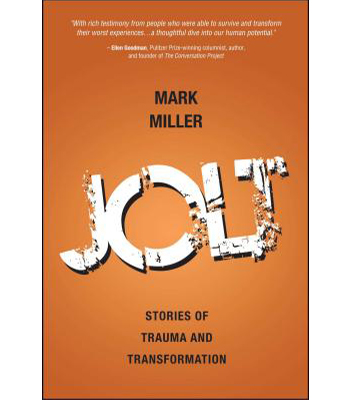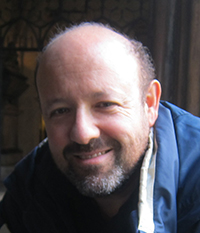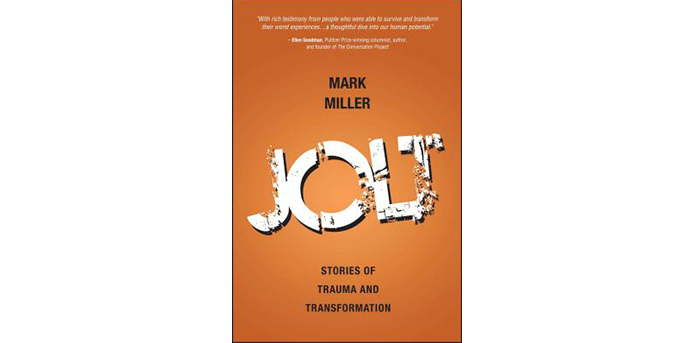Trauma can destroy lives, yet some people not only survive trauma, but they also bounce back to thrive and grow. For more than a decade, Evanston-based journalist Mark Miller, a nationally recognized expert on retirement and aging, has researched and written about what motivates people to reinvent their lives.
His new book, “Jolt: Stories of Trauma and Transformation,” tells the stories of people transformed by growth following trauma, and the new paths that they pursue. Some are on missions to help others or to make things right in the world, while others embark on new careers. Some people simply find that their relationships grow deeper, or seek a stronger spiritual dimension in their lives.
Jolts can derail us — or they can propel us into reclaiming and remaking our lives. They prompt us to ask questions about our values and purpose. Psychologists have been studying this phenomenon for some time; one research team at the University of North Carolina Charlotte back in the mid-1990s named the phenomenon “post-traumatic growth” (PTG). Since then, PTG has emerged as an important field of study for psychologists and social scientists.
Jolt explores a range of PTG experiences — the death of a child, life-threatening illness, plane crashes, terror attacks, natural disasters — and also a wide ranges of growth responses.
Readers will learn about the process of change that trauma survivors experience as they grow. What does the process of change look like from the inside for jolt survivors? What is the role of spirituality and faith? Who is most likely to experience growth after trauma — and who is not? And, what is the meaning of these stories of trauma and growth for the rest of us?
Here’s an excerpt from the book, available at various local bookstores:
 Lucia McBath strides onto a darkened stage as huge video screens flicker behind her. The lights in Philadelphia’s cavernous Wells Fargo Arena come up, and 19,000 cheering delegates to the 2016 Democratic National Convention rise to their feet. A chant begins: “Black lives matter. Black lives matter.” Lucia and eight other mothers who have endured the death of children killed in clashes with law enforcement officers or from gun violence look out at the convention hall full of waving placards, cheering, and tears. The television audience is 24 million.
Lucia McBath strides onto a darkened stage as huge video screens flicker behind her. The lights in Philadelphia’s cavernous Wells Fargo Arena come up, and 19,000 cheering delegates to the 2016 Democratic National Convention rise to their feet. A chant begins: “Black lives matter. Black lives matter.” Lucia and eight other mothers who have endured the death of children killed in clashes with law enforcement officers or from gun violence look out at the convention hall full of waving placards, cheering, and tears. The television audience is 24 million.
The convention delegates have just watched a video telling the story of a private meeting Hillary Clinton held with these mothers, and it ended with a swelling, emotional gospel lyric: “We are walking to the same place … We are walking to the pearly gates.” Geneva Reed-Veal quieted down the hall and spoke about her daughter, Sandra Bland, who died in a jail cell after a traffic stop led to her arrest. Now it is Lucia’s turn.
“You don’t stop being a mom when your child dies,” Lucia tells the convention when she gets up to speak. “You don’t stop being a parent. I am still Jordan Davis’s mother. His life ended the day he was shot and killed for playing loud music, but my job as his mother didn’t. I still wake up every day thinking about how to parent him, how to protect him and his legacy, how to ensure his death doesn’t overshadow his life.”
Four years earlier, Lucia — who goes by Lucy — was a flight attendant for Delta Airlines; she had spent most of her adult life focused on being a mom, and on her work. Everything changed for her on the Friday after Thanksgiving in 2012, when her 17-year-old son, Jordan, and three other teenagers went to spend the afternoon at a mall in Jacksonville, Florida. Jordan did some shopping and stopped at a gas station to buy cigarettes before heading home to play video games. They were four African-American male teenagers in a red SUV with the sound system cranked up high; the rap music was so loud, it could be heard around the parking lot. That’s what Michael David Dunn saw and heard when he pulled his sedan into the spot alongside the parked SUV. Dunn cracked open his window and told the kids to turn the music down. Jordan was in the back seat, and one of his buddies up front turned down the sound. But Jordan wasn’t in the mood to accommodate. He reached into the front to jack up the sound again — and a shouting match between him and Dunn ensued. When the dispute escalated, Dunn pulled a 9mm semi-automatic weapon from his glove compartment and fired 10 shots into the SUV, killing Jordan.
Now Lucy looks out at an arena full of convention attendees. She is a natural public speaker these days and doesn’t usually get nervous in front of a crowd. But the convention is something different — getting up in front of a huge audience in the arena and looking into the television cameras. She manages to pull herself together. “My whole mentality going out on stage was, I’m on a mission to save as many people as I can, and this is the opportunity to sell that to the world,” she remembered later. Lucy and the other mothers received several standing ovations. “What I saw was love,” she said. “We were being loved.”
The women have banded together as a group called the Mothers of the Movement, and they often say that they are members of a club no one wants to join. They have suffered the worst pain any parent can imagine: the loss of a child. Trauma of some kind strikes us all sooner or later — it is universal, an unavoidable part of human experience. The loss of a loved one. A physical illness that threatens life or capacity. Divorce. Natural disaster. An earthquake. Explosions. Fires. Terror attacks. Trauma damages lives, and it can ruin them. But Lucy McBath is a member of another club too. Its members have suffered traumas that set the stage for positive growth and transformation. For these people, trauma has intensified life in ways that have made it impossible to continue as they were.
We all walk around with a self-constructed sense of our world — what has happened to us in the past, expectations for the future, who and what matters to us, and how we hope to spend our time. Traumatic events can blow these self-constructed world views to pieces. They can force people to answer piercing questions about their priorities and values. These internal struggles can inspire profound and lasting personal growth. People may become more compassionate toward the plight of others — they develop a vastly expanded sense of empathy that extends far beyond the usual tight network of concern for family, friends, and one’s immediate community. Often, they pursue missions to help others or to make things right in the world. Some move into new careers and remake their worldview and personalities. Some find that their relationships grow deeper, and they may seek a stronger spiritual dimension in their lives.
I first became interested in these transformations through my work as a journalist covering retirement and aging. One of the most important themes in my work doesn’t concern retirement at all, but people who have remade their careers at midlife or later. I’ve interviewed dozens of people who are hell-bent on changing their lives and careers to focus on work with more purpose and meaning. And over the years, I began to notice a pattern: many leap-of-faith transformations begin with unforeseen traumatic life events. I came to think of these high-voltage bolts out of the blue as jolts — painful events that stop people in their tracks and then thrust them toward positive change.
In one sense, this is a book about loss. You will meet Lucy McBath and others who have suffered the loss of children and spouses, or their health. Others have survived plane crashes, terror attacks, explosions, and tsunamis. You’ll also meet people who suffered traumas less dramatic or visible from the outside. But they have all not only survived traumatic life jolts; they have been transformed by them, responding with courage, inspiration, and dogged determination. Such jolt survivors often become more self-reliant, more fearless, and bigger risk-takers.
Liz and Steve Alderman lost their 25-year-old son, Peter, in the terrorist attack on the World Trade Center on Sept. 11, 2001. They have built a successful global nonprofit organization that builds mental health clinics in post-conflict societies around the world, training indigenous health workers and establishing trauma treatment systems. Their strategy is to improve the quality of life of survivors, to create healthier, peaceful populations, and to push mental health higher on the global health agenda.
A freak explosion and fire on the job left electrical worker Dave Schury with burns all over his body, and he almost didn’t survive. Incredibly, he was back at work three months later, but the fire had changed him. As he recovered, Dave also began visiting burn victims in the hospital and working at an annual summer camp for child burn victims; later, he started a foundation that raises funds for college scholarships for young people who have suffered burns.
Marietta Jaeger was on a Montana camping trip in the summer of 1973 with her parents, husband, and their five children when horror struck: her seven-year-old daughter, Susie, was abducted during the night from a tent where she was sleeping with her sisters and brothers. A 15-month ordeal ensued as the family waited to learn Susie’s fate: she had been sexually assaulted and brutally murdered by a serial killer. A self-described suburban mom and “country bumpkin with a high school education,” Marietta has since devoted much of her life to fighting for abolition of the death penalty — a quest that began with what she calls a revelation of faith that led her to forgive the killer.
As a child, Hanh Meyers had always wanted to be a writer, but her family pushed her into a career in law — and in her early thirties, she was a hard-charging litigator on a fast path to partnership in a law firm. She was married and had given birth to a son, and her life path seemed clear. Then her husband, John, was diagnosed with brain cancer and passed away a year later, leaving Hanh with a one-year-old child to raise. After John’s death, Hanh quit her job and has since been traveling the world with her son. She now feels that she has the courage to seek out the life she envisioned for herself as a child but hadn’t previously found a way to pursue.
Andrew Revkin had a stroke that temporarily paralyzed his right hand — quite a wake-up call for a journalist who typed on a keyboard every day, as well as for a musician who relied on his hands to perform. An award-winning journalist and author who has written on science and the environment, Andrew has been writing and performing on guitar, mandolin, and banjo since the 1990s as a side gig to his journalism career, but he’d never pursued his music seriously. After the stroke, the procrastination stopped. Two years later, he released his first album of original songs, and he maintains a busy performance schedule in the New York City area.
How is it that some people manage to not only survive jolts but emerge from the experience stronger in many ways? What is it like to undergo such painful, profound change? How do these transformations occur?
Psychologists have been asking some of the same questions for years. Researchers at the University of North Carolina Charlotte named the phenomenon “post-traumatic growth” in the mid-1990s; since then, post-traumatic growth has emerged as an important field of study for psychologists and social scientists alike. One of those researchers, Lawrence Calhoun, says it is important to understand that post-traumatic growth is more than mere resilience in the face of trauma. The big difference is change. “Resilience is when you get punched, stagger, and then jump right back up,” he says. “Post-traumatic growth is different: When you stand back up, you are transformed.”
For jolt survivors, change begins when their framework for living is demolished by pain and suffering. Yet most regard that destruction as a gift. They have clarity of mind and purpose, and a heightened sense of compassion. Jolt survivors who have experienced the most dramatic transformations find themselves driven by a radically expanded sense of empathy for the plight of others and a powerful urge to help. But what lessons can others learn from their stories? How do these stories of change apply to people in less extraordinary circumstances?
What about people experiencing more everyday problems — such as dissatisfaction with work, a job loss, relationship stress, or the ill health of a family member? Those may not be “traumas” large enough to force dramatic change. But “things will happen in your life, and it doesn’t have to be dramatic,” says Hanh Meyers. “No matter what it is, everyone is trying to recover from something — whether it’s a bad childhood, or a bad choice, or the loss of a spouse — everyone is suffering from something. You don’t have to wait for a big traumatic thing to happen — you have a choice to be an active participant in your own life.”
More from Make It Better:
- 9 of the Best Recent Books in Translation
- 5 New and Noteworthy Books to Read This Spring
- 9 of the Best Beach Reads to Pack on Vacation
 For more than a decade, Mark Miller has researched and written about what motivates people to reinvent their lives. The Evanston-based journalist and author is a nationally recognized expert on retirement and aging. He is a columnist for Reuters and other news outlets, and a contributor to The New York Times. Miller is the author of “The Hard Times Guide to Retirement Security.” Mark’s local causes include the social justice-focused synagogue Tzedek Chicago, where he is a founding board member. He also is a supporter of Open Communities, which was co-founded in 1970 by his late parents Rayna and Marvin Miller to create more inclusive communities on the North Shore (then, it was called the North Shore Interfaith Housing Center). Get in touch with Mark through his website, or via Twitter @retirerevised
For more than a decade, Mark Miller has researched and written about what motivates people to reinvent their lives. The Evanston-based journalist and author is a nationally recognized expert on retirement and aging. He is a columnist for Reuters and other news outlets, and a contributor to The New York Times. Miller is the author of “The Hard Times Guide to Retirement Security.” Mark’s local causes include the social justice-focused synagogue Tzedek Chicago, where he is a founding board member. He also is a supporter of Open Communities, which was co-founded in 1970 by his late parents Rayna and Marvin Miller to create more inclusive communities on the North Shore (then, it was called the North Shore Interfaith Housing Center). Get in touch with Mark through his website, or via Twitter @retirerevised

